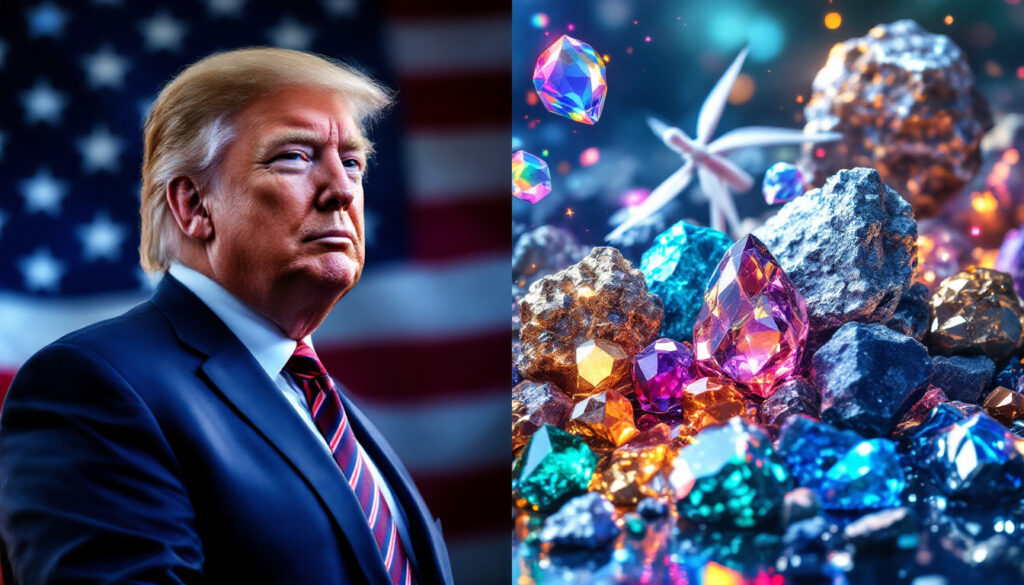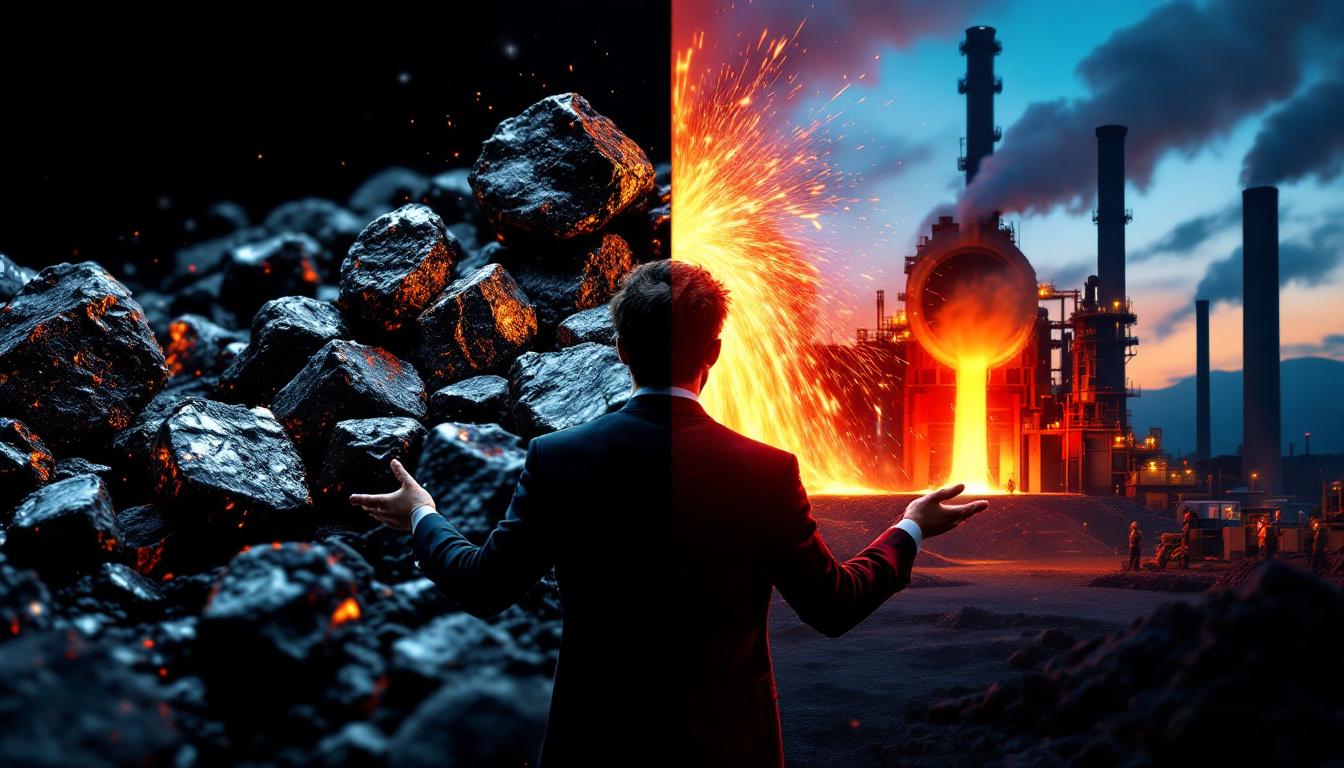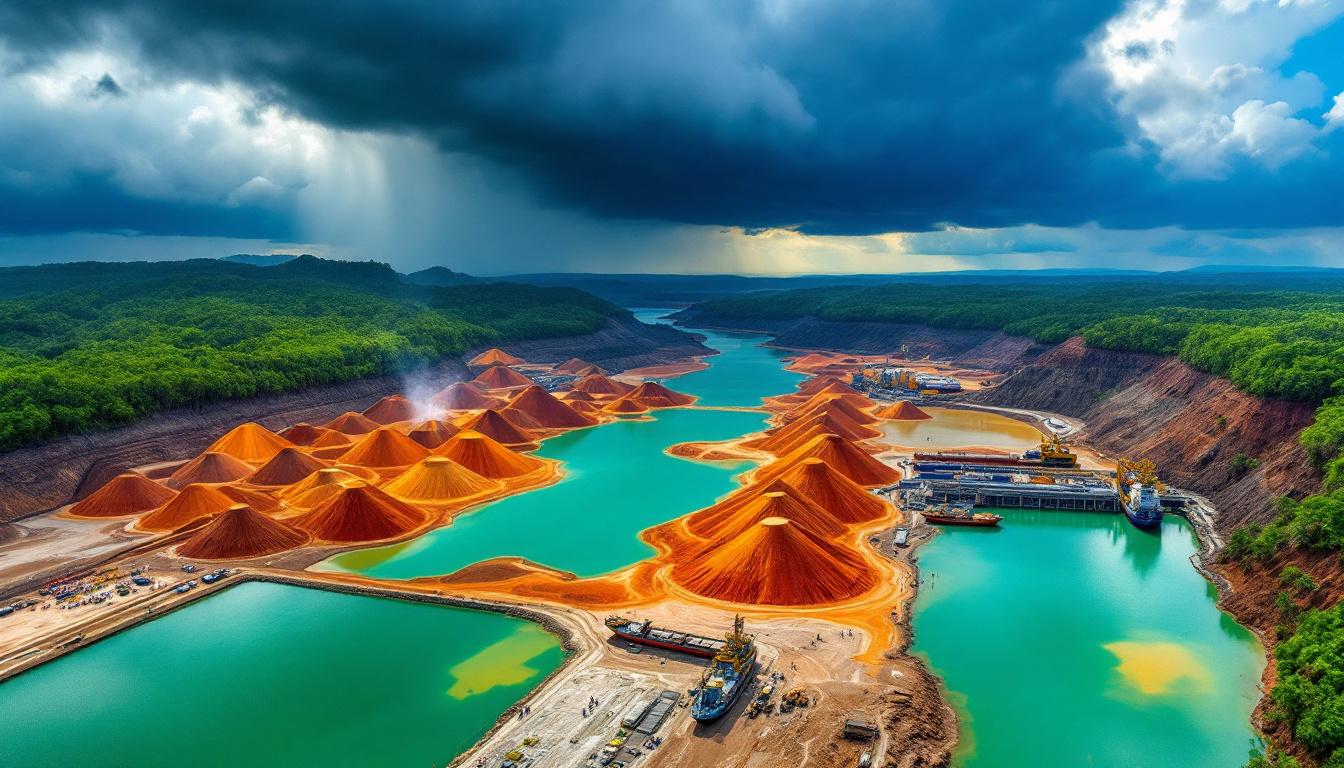Trump's Critical Mineral Strategy: Impacts on US Energy Security and Supply Chains
The geopolitical landscape of critical minerals has become a central focus of U.S. policy, particularly under former and potentially future Trump administration policies. With China's export restrictions in the supply chain and growing demand for minerals essential to clean energy technologies, Trump's strategy and critical mineral supplies have significant implications for America's energy security and global competitiveness.
What Are Critical Minerals and Why Do They Matter?
Critical minerals form the foundation of modern economies and are particularly essential for clean energy technologies. While often overlooked in policy discussions, these resources have become central to national security planning and economic strategy.
Definition and Classification of Critical Minerals
The U.S. Geological Survey (USGS) identifies 50 minerals as "critical" based on their importance to economic and national security combined with supply chain vulnerabilities. These include cobalt, lithium, manganese, nickel, copper, silicon, graphite, arsenic, gallium, and tellurium—materials that most consumers never see but depend on daily.
"Critical minerals are defined by their irreplaceability in key technologies and high risk of supply disruption," explains the USGS in its annual mineral commodity summaries.
The criticality of these minerals isn't static—it evolves as technologies advance and geopolitical situations shift. For instance, lithium wasn't considered particularly strategic until the electric vehicle revolution began accelerating in the 2010s.
Global Significance for Clean Energy Transition
These minerals are the literal building blocks of the clean energy transition. Electric vehicle batteries require lithium, cobalt, nickel, and graphite in massive quantities. Solar panels depend on silicon, copper, silver, and tellurium. Wind turbines need rare earth elements for their permanent magnets.
Deutsche Bank projects graphite demand for lithium-ion batteries alone will grow by approximately 500% by 2030. This exponential growth creates tremendous pressure on supply chains that were never designed for such volumes.
Processing capacity represents perhaps the most significant bottleneck. While mining operations are expanding globally, refining these raw materials into battery-grade chemicals or semiconductor-ready materials remains concentrated in China, creating vulnerabilities that have attracted bipartisan concern in Washington.
How Does China Dominate the Critical Minerals Supply Chain?
China's strategic foresight in building comprehensive critical mineral supply chains has given it unprecedented leverage in global clean energy markets—a position that took decades to develop but could take equal time to diversify away from.
China's Market Control
China didn't achieve its dominant position by accident. Through deliberate industrial policy spanning over 20 years, China now controls approximately 60% of global critical minerals production and an even more concerning 85% of global processing capacity.
This control extends across the value chain. For example, China processes nearly 100% of the world's natural graphite for batteries and dominates rare earth element processing with over 85% market share.
The advantages extend beyond mere capacity. As Tom Moerenhout of Columbia University notes, "Chinese suppliers benefit from standardization, technological advancement, and state subsidies that create insurmountable cost advantages for new market entrants."
These subsidies, estimated to exceed $100 billion over the past decade for clean energy supply chains, have helped Chinese companies undercut potential competitors and cement market dominance.
Strategic Investments in Global Resources
China's mineral strategy extends well beyond its borders. In the Democratic Republic of Congo, which produces over 70% of global cobalt, Chinese companies have invested more than $2 billion in mining operations since 2020.
Similarly, Indonesia's nickel industry, which accounts for about 40% of global supply, has been transformed by Chinese investment. Over 60% of Indonesia's nickel processing capacity is now backed by Chinese capital.
In January 2025, China significantly escalated tensions by imposing export restrictions on five critical minerals: bismuth, indium, molybdenum, tungsten, and tellurium. These restrictions followed similar controls on gallium and germanium in 2023, vital materials for semiconductor manufacturing.
Perhaps most concerning for Western nations is China's recent restrictions on engineering talent leaving the country—a move that limits knowledge transfer and maintains technological advantages in processing techniques.
"China deliberately uses its control of critical mineral supply chains as leverage in trade negotiations," observes Seaver Wang of the Breakthrough Institute. "This strategy is particularly effective against countries attempting rapid clean energy deployment."
What Is Trump's Strategy for Critical Minerals?
Trump's approach to critical minerals reflects his broader economic nationalism, emphasizing tariffs and trade actions while reducing regulatory barriers for domestic production.
Tariff Policies and Trade Actions
The cornerstone of Trump's critical minerals strategy involves aggressive tariff policies aimed at reshoring production. His administration has implemented a 20% blanket tariff on all Chinese imports and maintained the Biden administration's planned increase on lithium batteries from 7.5% to 25%, set to take effect in January 2026.
Beyond China-specific measures, Trump imposed 25% tariffs on all steel and aluminum imports globally, arguing these metals are fundamental to national security. More controversially, he applied matching 25% tariffs on all imports from Mexico and Canada—America's largest trading partners and critical mineral suppliers.
The administration has also supported antidumping and countervailing duties on Chinese active anode materials, with some tariff rates exceeding 130% for specific products deemed to be unfairly subsidized.
"The rapid escalation of tariffs risks inflating costs throughout the supply chain before domestic alternatives can scale," warns industry analyst James Wu. "This creates a challenging transition period for downstream manufacturers."
International Resource Acquisition Plans
Recognizing that domestic resources alone cannot meet U.S. needs, Trump's strategy and critical mineral supplies include securing more critical mineral assets in resource-rich countries aligned with American interests.
The administration has prioritized expanding control of resources in Greenland, which holds substantial rare earth deposits, and in Ukraine, which possesses significant lithium and titanium reserves. These efforts include diplomatic pressure, investment incentives, and strategic partnerships with American mining companies.
In the Democratic Republic of Congo, which dominates global cobalt production, U.S. diplomatic and commercial efforts have intensified to counter Chinese influence, though with limited success to date.
Policy Shifts from Previous Administration
Trump's approach marks significant departures from previous policies. The administration has frozen funding from the Inflation Reduction Act and Bipartisan Infrastructure Law pending comprehensive review, creating uncertainty for projects already in development.
The reduced federal workforce in key agencies involved in mining regulation—including a 30% staff reduction at the Bureau of Land Management—has created processing backlogs for mining permits and environmental reviews.
While the administration has promised to streamline regulatory processes for new U.S. mines and processing sites, particularly by reforming the National Environmental Policy Act, concrete reforms remain largely unrealized, creating a policy environment marked more by uncertainty than clarity.
How Vulnerable Is the US Critical Minerals Supply Chain?
America's vulnerability in critical minerals extends beyond mere import dependence—it reflects decades of underinvestment in processing capacity and the extremely long timeline required to develop new projects.
Current US Production and Processing Capacity
The United States has little to no cobalt and graphite mining or processing capacity, despite these minerals being essential for batteries. Even where the U.S. does have resources, processing capacity remains minimal, with only 3% of global nickel processing capacity and just 1% of global lithium processing capacity.
Most concerning is the time required to develop alternatives. The average critical minerals mine takes over 16 years from discovery to production in North America, compared to 7-10 years in Australia and less in some developing nations. Processing facilities face fewer delays but still require 5-7 years from planning to operation.
"We have geological potential but lack processing know-how," explains Dr. John Thompson, a resource economist. "Many processing techniques were pioneered in the U.S. but have been perfected in China, where they're now treated as trade secrets."
Import Dependencies and Vulnerabilities
The U.S. relies heavily on China for highly processed critical minerals, particularly battery materials and rare earth elements. For instance, approximately 75% of U.S. cobalt imports come directly or indirectly from Chinese processors.
This dependency extends to friendly nations as well. Canada exported $29.8 billion in critical minerals to the U.S. in 2023, including 96% of America's imported potash and 74% of its aluminum. British Columbia Premier David Eby has threatened to ban critical mineral exports to the U.S. in retaliation for tariffs, calling such policies "self-destructive."
Perhaps most concerning is that U.S. tariff disputes now target its top three raw materials suppliers simultaneously—China, Canada, and Mexico—creating what Wang calls "a perfect storm of supply chain vulnerability at the worst possible time."
What Are the Impacts on Clean Energy Development?
The consequences of critical mineral supply disruptions extend throughout America's clean energy ambitions, potentially delaying deployment timelines and increasing costs for consumers and businesses.
Effects on US Renewable Energy Projects
Solar, wind, and battery developers are particularly sensitive to tariff escalation and supply disruptions. For example, China's export restrictions on tellurium directly impact cadmium telluride thin-film solar cells, which represent about 40% of U.S. solar manufacturing capacity. First Solar, America's largest solar manufacturer, has already reported supply challenges related to these restrictions.
Higher costs for critical minerals make downstream industries like battery manufacturing less competitive globally. One analysis suggests U.S. battery costs could be 25-35% higher than Chinese alternatives by 2026 if current tariff trajectories continue, potentially undermining the economic case for domestic manufacturing.
The policy uncertainty creates what Moerenhout calls a "chilling effect" on future investments. "Companies need 5-10 year horizons for major capital investments in processing capacity," he notes. "When policies change with each administration, investors prefer to wait and see rather than commit billions."
Timeline for Supply Chain Resilience
According to Argonne National Laboratory analysis, domestic lithium supplies could meet demand from U.S. battery manufacturing by 2030, but only if support mechanisms from the Inflation Reduction Act remain intact. The suspension of these programs threatens this timeline.
Progress with other critical minerals shows less promise. Cobalt, graphite, and nickel face more significant challenges, with domestic self-sufficiency unlikely before 2035 even under optimistic scenarios.
Most concerning is that new mining and processing projects have not yet quantitatively shifted the global supply picture. Despite announcements totaling over $15 billion in new U.S. processing capacity since 2021, most projects remain in planning or early construction phases, with commercial production still years away.
How Could the US Build Resilient Critical Mineral Supply Chains?
Building truly resilient critical mineral supply chains requires a comprehensive approach combining domestic production enhancements with strategic international partnerships.
Domestic Production Enhancement
Successful critical mineral strategies must include project-specific grants and loans for mining and processing facilities. Programs like the Department of Energy's $600 million Advanced Materials Production grant program provide critical de-risking capital for new facilities.
Support for R&D in new mining and processing technologies can help overcome technical barriers. For instance, direct lithium extraction technologies could unlock previously uneconomic domestic resources by reducing water usage and environmental impacts.
Government assistance with geologic mapping and resource assessment helps companies identify promising deposits. The USGS Earth Mapping Resources Initiative requires consistent funding to provide this crucial public good.
Permitting reforms to accelerate project development remain essential but controversial. Reviews under the National Environmental Policy Act currently average 4.5 years for mining projects—streamlining these processes without sacrificing environmental protection requires careful balancing.
International Partnerships and Trade
Industry experts widely recognize that some extraction and processing will always be more competitive in partner countries due to resource quality, energy costs, and labor markets. Building secure supply chains with allies like Canada, Chile, and Australia creates resilience without expecting complete self-sufficiency.
Bilateral agreements with resource-rich friendly nations can create preferential access to materials. The U.S.-Chile Critical Minerals Partnership, for instance, provides American companies priority access to Chilean lithium in exchange for investment in value-added processing.
Direct funding from agencies like the Department of Defense and U.S. Export-Import Bank supports overseas projects aligned with American interests. The Rhyolite Ridge lithium project in Nevada received $700 million in DOD funding in 2023, demonstrating the strategic importance of these resources.
"The solution isn't reshoring everything," emphasizes Moerenhout. "It's building diversified, resilient supply chains with trusted partners while developing strategic domestic capabilities in the most critical segments."
FAQ: Critical Minerals and US Energy Security
What are the most important critical minerals for clean energy?
Lithium, cobalt, nickel, and graphite are crucial for battery storage and electric vehicles. A typical EV battery requires 8-10kg of lithium, 4-30kg of cobalt (depending on chemistry), and up to 70kg of graphite.
Copper is essential for solar panels, wind turbines, and electrical connections throughout clean energy systems. A single offshore wind turbine contains approximately 8 tons of copper.
Silicon remains a key component in photovoltaic panels, which still dominate the solar market. Rare earth elements like neodymium and dysprosium are critical for wind turbine permanent magnets, with a typical 3MW turbine containing about 600kg of rare earth elements.
How does the critical minerals shortage affect renewable energy goals?
Critical mineral constraints create supply bottlenecks for manufacturing components, potentially delaying project timelines by 6-18 months. According to Benchmark Minerals Intelligence, lithium demand could outstrip supply by 2030 without significant new production.
These shortages increase costs for clean energy technologies. Bloomberg NEF estimates that raw material costs account for 50-70% of battery cell costs, making these technologies particularly sensitive to mineral price fluctuations.
Supply chain vulnerabilities introduce geopolitical risks that can disrupt deployment plans. For instance, China's restrictions on tellurium exports directly impact thin-film solar manufacturing in the United States.
What alternatives exist to reduce dependency on critical minerals?
Research into alternative battery chemistries that use more abundant materials shows promise. Sodium-ion batteries, which eliminate lithium and cobalt, have reached commercial production in China and are approaching cost parity with lithium-ion for stationary storage applications.
Recycling programs to recover minerals from end-of-life products will become increasingly important. By 2035, recycled materials could meet approximately 30% of cobalt demand and 20% of lithium demand in the battery sector.
Material efficiency improvements continue to reduce mineral intensity. For example, cobalt content in NMC batteries has decreased by approximately 75% over the past decade through chemistry innovations.
Development of substitute materials with similar properties remains an active research area. Silicon carbide can replace graphite in some applications, while aluminum can substitute for copper in certain electrical components, though usually with performance trade-offs.
How do tariffs impact the critical minerals market?
Tariffs can help domestic producers compete against subsidized foreign suppliers by leveling price differentials. The 25% tariff on Chinese graphite, for instance, makes U.S. synthetic graphite more competitive.
However, tariffs may increase costs for downstream manufacturers if raised too quickly before domestic alternatives scale. Battery manufacturers report 15-20% cost increases when forced to rapidly switch supply chains.
Tariffs often trigger retaliatory measures from trading partners. Canada's threat to restrict critical mineral exports in response to steel tariffs exemplifies this risk, potentially creating a negative feedback loop of trade restrictions.
Perhaps most concerning, tariffs create market uncertainty that discourages long-term investments. As Wang notes, "investors need policy stability to commit billions to decade-long projects—trade volatility is the enemy of capital-intensive industries like mining and processing."
The path forward requires balancing immediate geopolitical investment strategies with long-term supply chain resilience, taking into account both lithium oversupply challenges and opportunities from emerging regions like Africa's critical minerals. The critical minerals sector is entering what some analysts call a new global super cycle that will fundamentally reshape international trade and energy security priorities.
Want to Capitalise on the Next Major Mineral Discovery?
Discover significant ASX mineral announcements in real-time with Discovery Alert's proprietary Discovery IQ model, transforming complex market data into actionable investment insights. Visit Discovery Alert today to understand why catching mineral discoveries early can lead to exceptional returns for your portfolio.




